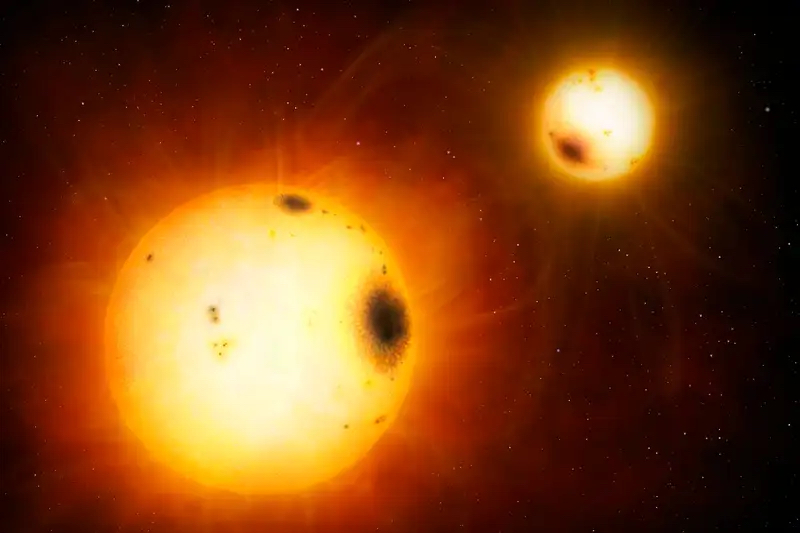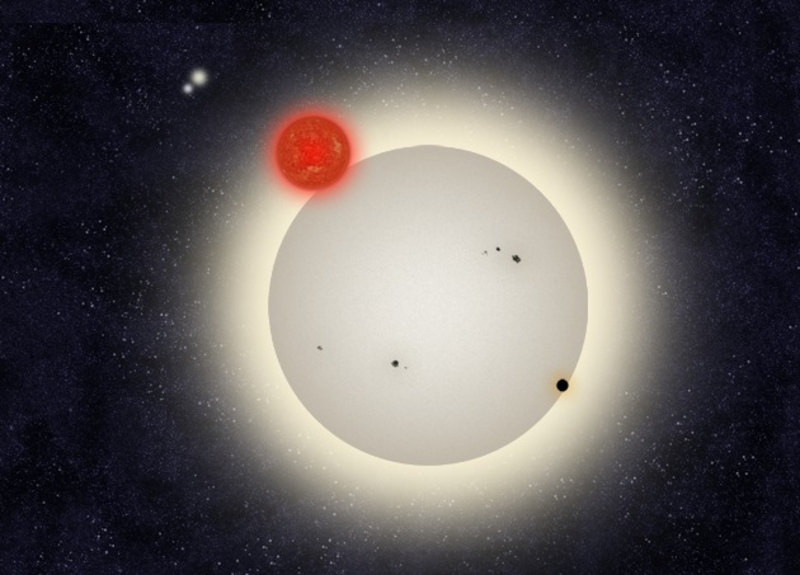
Planets orbiting in their stars’ Goldilocks zones or habitable zones are not too close and not too far from their stars. They’re in a place where water might exist as a liquid on a rocky planet. We tend to think of a planet in the Goldilocks zone of a single star, similar to Earth in our solar system. But what about multiple star systems? Do habitable zones exist in systems of two, three or more stars? Astronomers from New York University Abu Dhabi and the University of Washington show that it is indeed possible. Using a new mathematical model, they found that at least five such known systems – all within 6,000 light-years of Earth – have stable habitable zones where hypothetical planets could harbor life.
The peer-reviewed study was published in Frontiers in Astronomy and Space Sciences on April 15, 2021, and reported in Frontiers Science News on the same day.
These findings are important because stable habitable zones would greatly increase the chances of life evolving on any planets that orbit within them. As lead author Nikolaos Georgakarakos said:
Life is far most likely to evolve on planets located within their system’s habitable zone, just like Earth. Here we investigate whether a habitable zone exists within nine known systems with two or more stars orbited by giant planets. We show for the first time that Kepler-34, -35, -64, -413 and especially Kepler-38 are suitable for hosting Earth-like worlds with oceans.

The astronomers studied nine different multi-star systems, and found five of those – Kepler-34, Kepler-35, Kepler-38, Kepler-64 (PH 1) and Kepler-413 – to be the most likely to contain permanent habitable zones with worlds that could host life. Of those, they found Kepler-35, Kepler-38 and Kepler-64 to offer the most benign environment for possible life.
The five star systems are located at distances between 2,764 and 5,933 light-years from Earth, in the constellations Lyra the Harp and Cygnus the Swan. Kepler-64 has at least four stars orbiting each other (!), and the rest are binary star systems with two stars.

It is important to note that while smaller rocky planets haven’t yet been found in these star systems, they are all known to have at least one planet as large as Neptune or bigger. This makes it likely that at least some of them also have smaller planets, since most planetary systems found so far tend to have planets of various sizes, like ours.
Generally, multi-star systems are thought to be less likely to have habitable planets, due to all the intricate gravitational interactions going on, especially those with giant planets. But now this new research shows that some of them could be stable enough for life to originate on habitable zone planets. Co-author Ian Dobbs-Dixon said:
We’ve known for a while that binary star systems without giant planets have the potential to harbor habitable worlds. What we have shown here is that in a large fraction of those systems Earth-like planets can remain habitable even in the presence of giant planets.
This is good news for the prospects of finding life in such systems, since, for example, double star systems are estimated to compose up to 3/4 of all star systems. Our single star sun is actually in a minority.
How did the researchers come to these conclusions? Their work is based on previous studies, with the goal of determining the existence, location, and extent of the permanent habitable zone in binary systems with giant planets. The researchers take various factors into consideration, such as the classification, mass, luminosity and spectral energy distribution of the stars, the added gravitational effect of the giant planet and the geometry of the system; the orbital eccentricity (how narrow an ellipse the orbit is), semi-major axis and period of the hypothetical planet’s orbit. They also look at the intensity of solar radiation from the star hitting the planet’s atmosphere and the planet’s climate inertia, the speed at which the atmosphere responds to changes in irradiation.
By doing this, they determined that those five multi-star systems do indeed have permanent habitable zones. Each zone is between 0.4 and 1.5 astronomical units (AU) wide. One AU is the mean distance between Earth and the sun, about 93 million miles (150 million km).
Other binary star systems are not as promising, however. In the Kepler-453 and Kepler-1661 systems, the habitable zones are estimated to be only about half the size as those of the other five. Two others, Kepler-16 and Kepler-1647, are unlikely to have any potentially habitable planets at all. As noted by co-author Siegfried Eggl:
In contrast, the extent of the habitable zones in two further binary systems, Kepler-453 and -1661, is roughly half the expected size, because the giant planets in those systems would destabilize the orbits of additional habitable worlds. For the same reason Kepler-16 and -1647 cannot host additional habitable planets at all. Of course, there is the possibility that life exists outside the habitable zone or on moons orbiting the giant planets themselves, but that may be less desirable real-estate for us.

So which system has the most potential for supporting life? Georgakarakos said:
Our best candidate for hosting a world that is potentially habitable is the binary system Kepler-38, approximately 3,970 light-years from Earth, and known to contain a Neptune-sized planet.
Our study confirms that even binary star systems with giant planets are hot targets in the search for Earth 2.0. Watch out Tatooine, we are coming!

Habitable worlds are not limited to the habitable zone, however. In our own solar system there are multiple icy moons with subsurface oceans that could potentially be home to some kind of life. Europa, Enceladus and Titan in particular are now prime targets for further exploration. The fact that they are common in our solar system makes it reasonable that similar kinds of moons may also exist in some of these multi-star systems, and elsewhere.
Bottom line: Astronomers have identified five multi-star systems that have stable habitable zones. This means that any rocky worlds that may exist in those zones could be potentially habitable.
Source: Circumbinary Habitable Zones in the Presence of a Giant Planet











